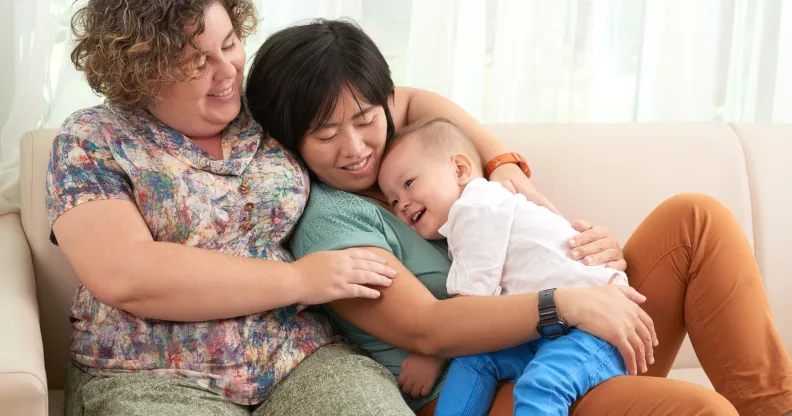Cisgender same-sex couples making babies together without a donor could soon become a reality

The technique could allow cisgender same-sex couples to have children biologically related to both of them. (Envato)
Researchers in China have said that they are currently testing a technique on monkeys that could allow cisgender same-sex couples to have babies biologically related to both of them.
The method has only been tested before on mice, but moving on to the next stage of research brings scientists a step closer to making it possible for humans.
In mammals, almost every cell in our body contains two sets of genetic material, one set each from the sperm and egg that fused to create us.
The only exceptions are sperm cells and egg cells. These sex cells, or gametes, contain just one set of genetic information so that they are able to combine at the point of fertilisation.
Genomic imprinting is when a gene has a biochemical marker specific to its parental origin (whether it came from the sperm cell or the egg cell).
For some genes it is essential that we only express the copy of genetic material provided by either the egg or the sperm rather than both, and so this marker silences the other.
For example, if genetic information from the sperm cell has a marker on a particular gene, then that gene will be switched off in the genetic information from the egg.
This causes a problem for cisgender same-sex couples who want to have biological babies because if, in the above example, both sets of genetic information were from cisgender women then both copies of the gene would be switched off.
The gene would then not be able to perform its function or make gene products, which could cause serious developmental problems for the offspring.
But at the end of 2018, a researcher in China discovered that by deleting imprinted regions using gene editing, they could produce healthy babies from two female mice. However, similar experiments with two male mice proved less successful, and the babies only survived a couple of days.
Researcher Wei Li told Discover Magazine that although the technique is not ready to use on humans, he and a team at the Chinese Academy of Sciences in Beijing are moving on to test it on monkeys, bringing us a step closer to cis same-sex couples being able to have biological children.
In 2015, another potential technique for allowing two cis humans of the same sex to have biological children was proposed.
In Vitro Gametogenesis (IVG) could in theory form a sperm cell from a cis woman’s stem cell or an egg cell from a cis man’s stem cells. It has already been perfected in mice, producing normal, healthy babies, but has not yet been tested on humans.
According to Dr César Palacios-González, a career development fellow in practical ethics at Oxford University, once same-sex couples are able to have biological children together it will destroy the homophobic argument that gay people shouldn’t naturally be together because they aren’t able to reproduce.
He added: “It will, in due course, just strengthen the case for same-sex marriage.”

